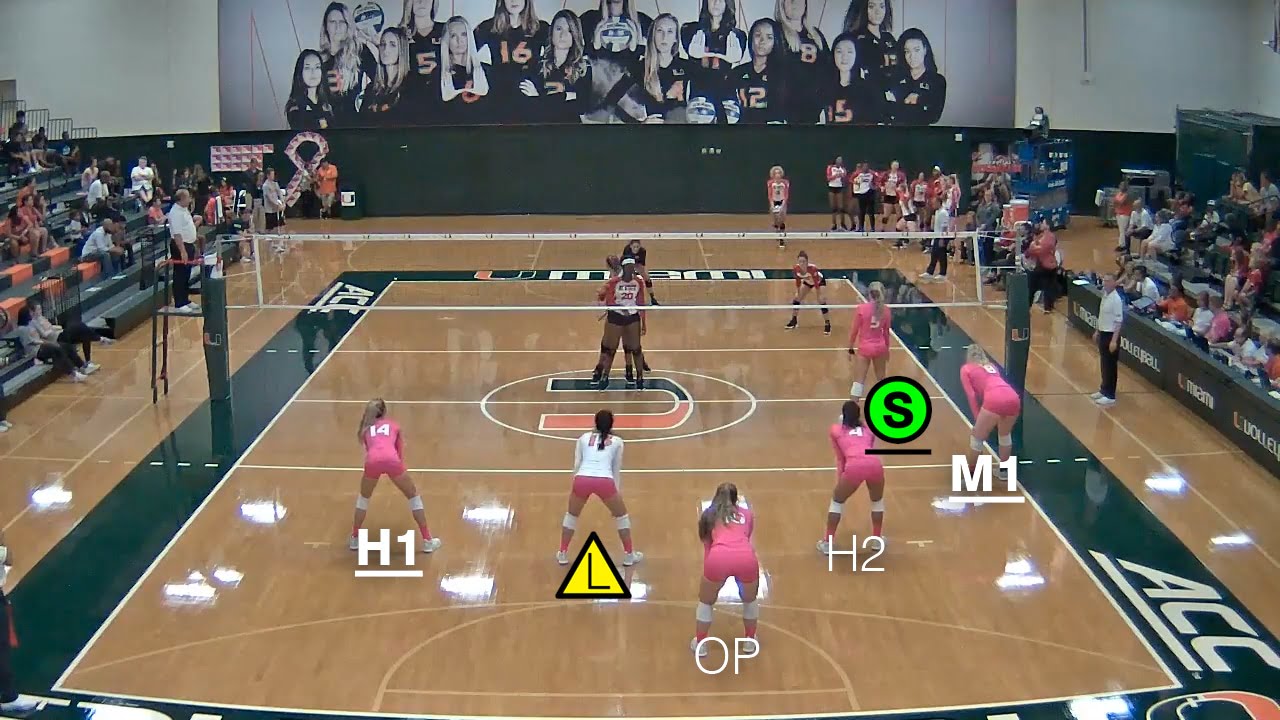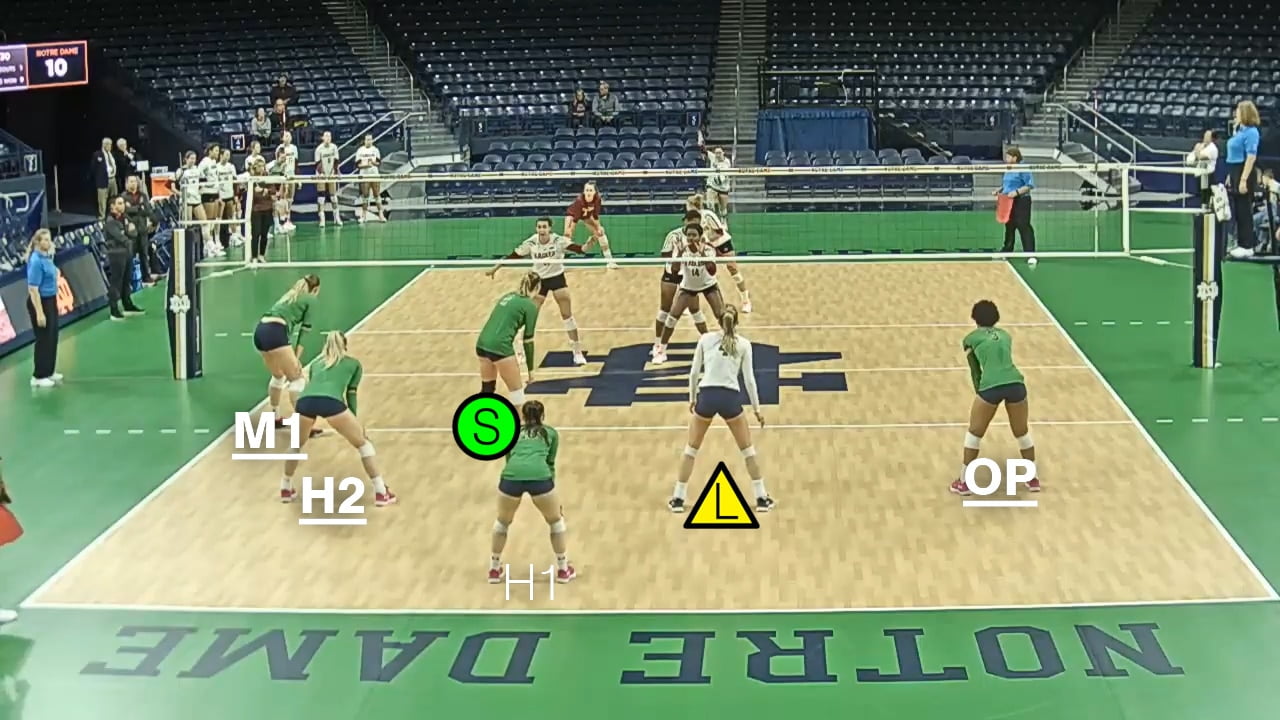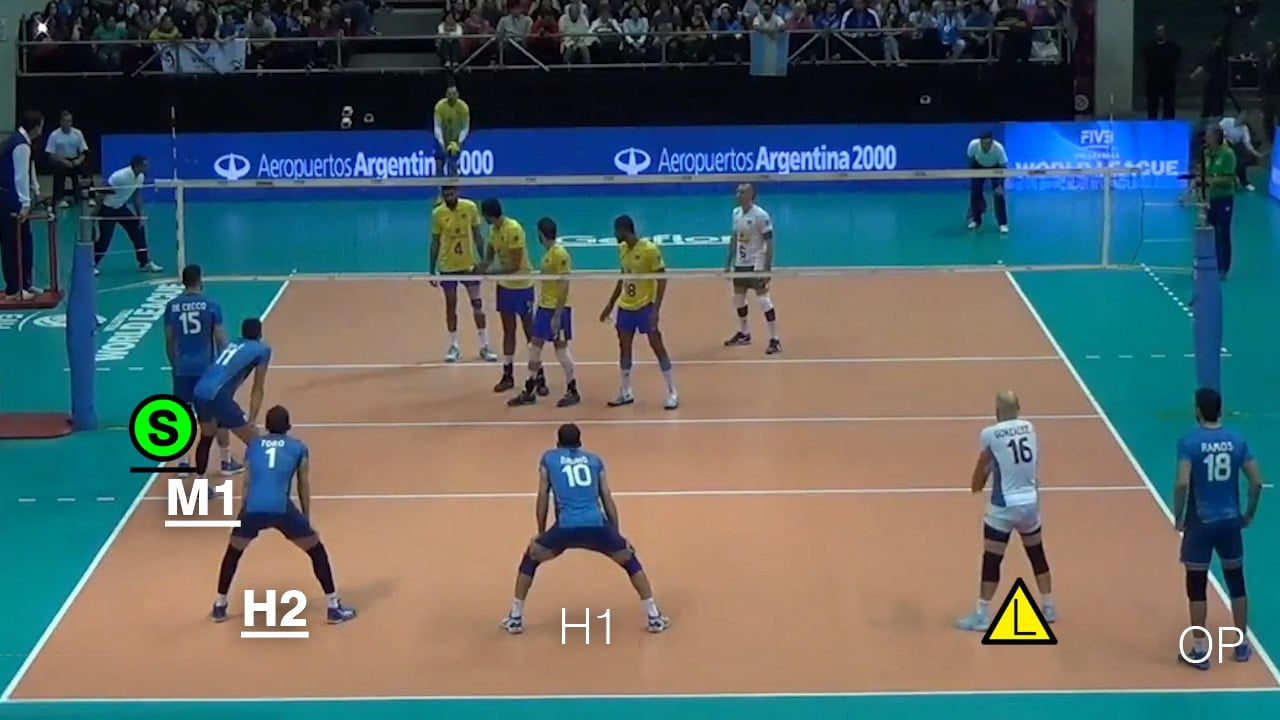6-2 VOLLEYBALL ROTATIONS - A COMPLETE GUIDE
The 6-2 volleyball rotation, which is commonly called the 6-2 offense, is a system used to optimize the offensive lineup of a volleyball team. Volleyball offensive systems are named based on the number of setters and hitters on the court. For example, a 6-2 volleyball rotation would include.
- 2 players that set
- 6 players available to spike
As another example, a 5-1 system would include.
- 1 dedicated setter
- 5 players available to spike.
For a better visual, we have provided you with a 6-2 volleyball rotations PDF or cheat sheet below. Feel free to download this Free PDF and use it however you’d like.
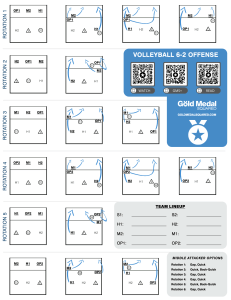
6-2 volleyball rotation pdf / cheat sheet
What makes the 6-2 volleyball rotation unique is that it allows for three primary variations depending on the abilities of your athletes.
- 6-2 Volleyball Rotations with 0 Substitutions
- 6-2 Volleyball Rotations with 1 Substitution
- 6-2 Volleyball Rotations with 2 Substitutions
6-2 Volleyball rotations with no subs
The 6-2 offensive system with no substitutions requires two athletes on the roster to each be a good setter and a strong attacker. Rather than having a single designated setter, this variation has 2 hybrid setter/opposites on court. These players are on the court at the same time, and depending on their back row or front row positioning, their role will change.
When they are in the front row they will play as a right-side attacker, and when they are in the back row, they will play as a setter. Finding athletes who are really good attackers and setters is not an easy task, but every now and again you will see teams that make it work.
Below is a GMS+ video illustrating how the 6-2 volleyball rotation with no subs works.
As the right side defender in position 1 rotates into the front row, they then become a front row right-side attacker. When the front row right side attacker rotates back to serve, they will then become the new setter for the three rotations when they are back row.
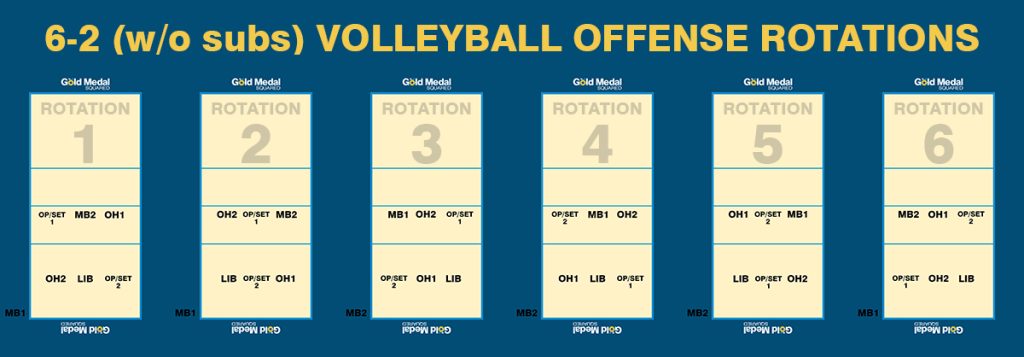
6-2 WITH NO SUBS - KEY POINTS
- The right-back defender will always set.
- The right-front attacker will always hit.
- Middles and outsides will continue in their roles as normal.
- You do not need to use any substitutions.
- You will always have three front-row attackers.
6-2 VOLLEYBALL ROTATIONS WITH 1 Substitution
The 6-2 Offense with 1 substitution allows for a coach to give players more specific roles on the court. This system requires the following players:
- 1 setter/opposite hybrid player
- 1 back row setter
- 1 front row opposite
This system gives a coach the opportunity to utilize ONE player that can be a strong front row attacker while also being a good back row setter.
As shown in the GMS+ video below, this system works by having the setter starting in the back row and the hybrid player starting in the front row. The setter plays as a back-row setter while the hybrid player plays as a front row opposite. After three rotations, the back-court setter will then rotate into the front row.
At this point, the opposite is substituted into the game in place of the front row setter. At the same time, the hybrid player enters the back row and becomes the team's setter for the next three rotations. The substitution will then be reversed after 3 more rotations when the opposite transitions into the back row.
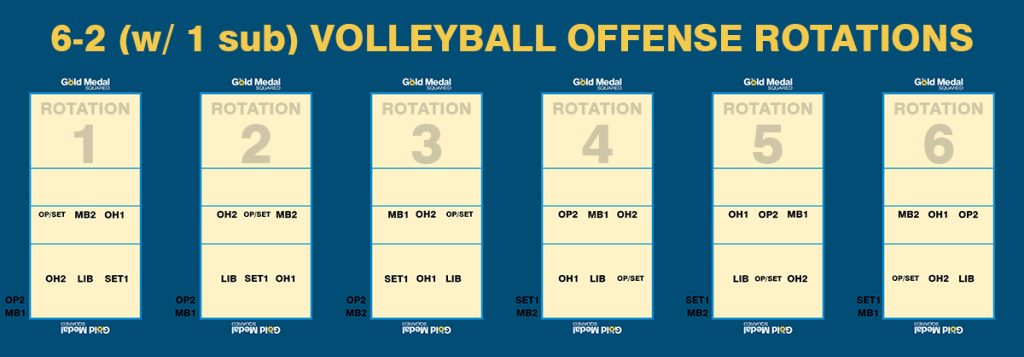
Advantages of the 6-2 rotation with 1 substitution
If a team has a strong setter who is not suited to playing in the front row, the 1 sub option gives that player a role (especially if she’s a really good setter).
As with other 6-2 volleyball rotations, this system also gives your team three front-row attackers at all times (a bonus).
Next, the opposite position is typically utilized for a power hitter. Ideally, this hitter should have the ability to hit in-system, and terminate sets out of system (especially in men’s volleyball). Having such a player for 3 rotations across the front row is a clear benefit.
Having a good opposite can also provide an opportunity to redefine the roles of other players within the team: for example, if you have a middle who blocks well but struggles offensively, you can allow them to focus more on the blocking aspect of their game while your pin attackers can carry the load offensively.
Another skill that this system allows for is when a team’s opposite is a strong server. The opposite can stay on the court for the extra rotation to serve when in position 1 without the team having to make an extra substitution. The hybrid player in position 4 would be able to play as the setter for that one rotation. The team now has a strong serving option that potentially wins points and the opposite can provide an extra back row attack option after serving (think transition).
Advantages summary
- The system requires one hybrid player which allows for more specialization.
- The team has three front-row attackers at all times.
- Takes advantage of one athlete who can be a good attacker and a good setter.
Disadvantages of the “6-2 System with 1 substitution”
Setter-hitter connections play an important role in offensive success. If a setter and hitter are unable to connect, frustration can build in both players and communication can tail off, resulting in a lack of trust within an important part of the team’s system.
In a system that uses two different setters, it’s possible to set up the rotations pairing attackers and setters who have good connections. Note, there will always be one rotation when the attackers will have to play with the second setter.
In a tight game situation this could cost a team more points than they gain if they are unable to break out of a serve receive rotation.
The success of the system could also come down to practice repetitions. A hybrid player could be a great attacker and have good hands, but it takes a player with a good volleyball IQ to run the offense.
For most high-level teams, this system is rarely used. Finding a hybrid player that checks all of the boxes is a challenge.
Disadvantages summary
- Hitters need to form setter-hitter connections with more than one setter.
- A hybrid player needs reps performing a variety of skills. This requires good planning and a player with a high volleyball IQ.
What style of team might benefit from running the “6-2 System with 1 substitution?”
If you have one versatile player that is a good attacker and a good setter this is a good option to consider. It allows you to take advantage of this player's strengths while also ensuring you have three offensive players in the front row at all times.
This system might also suit a team with limited substitutions, an opposite who struggles attacking out of the back row, or a setter that struggles in the front row.
If you have athletes who prefer playing with particular setters, then this system may work for you. Make use of the existing connections without having to make multiple substitutions.
If a team has a weakness with their middle blockers or outside hitters, having the opportunity to bring in an offensive opposite may be beneficial.
Team style summary
- Teams with a versatile player that would be a good attacker and good setter
- Teams with limited substitutions but no opportunity for two hybrid players.
- Teams with players preferring different setters.
- Teams with an attacking weakness in either a middle blocker or outside hitter.
6-2 Volleyball rotation with 2 substitutions
One of the most common offensive systems used in NCAA Women’s Volleyball and high school girl's volleyball is the 6-2 volleyball rotation with 2 substitutions.
What is the “6-2 volleyball rotation with 2 substitutions?”
With this variation of the 6-2, the right-side players are assigned very specific roles on the court. The system requires four right side players:
- 2 setters (S1 & S2)
- 2 opposites (OP1 & OP2)
This system gives the coach the opportunity to utilize two players with strong offensive skills on the right, along with two strong setters. It also ensures that there are always three front-row attackers available at all times throughout the match.
As shown in the GMS+ video below, this system works by having the setter S1 starting in the back row and the opposite player (OP1) starting in the front row. S2 and OP2 are not on the court at this time.
S1 plays as a backcourt setter while OP1 plays as a right-side front-court attacker. After 3 rotations, S1 will then rotate into the front row and OP1 will rotate into the serving position in the back row.
At this point, two substitutions are made. S2 comes into the match and replaces OP1 in the front row. OP2 comes into the match and replaces S1 in the front row. S2 is now the setter and OP2 the right side front court hitter, thus maintaining 3 front row attackers.
The substitutions will then be reversed after three more rotations when OP2 rotates back into the back row and this pattern of substitutions continues for the duration of the set (provided that the maximum number of substitutions permitted is not exceeded).
This system maintains three front-row attackers at all times by reversing the substitutions every time a setter rotates into the front row and an opposite rotates into the back row.
Advantages of the “6-2 System with 2 substitutions”
Players are able to commit themselves to a specific role within the team and thus be able to focus on developing the skillset required for that role.
The team will also have a dedicated strong right-side attacker and blocker in the front row for all six rotations. This allows the setters to distribute the ball effectively across the net and cause problems for opposition blockers and defenders.
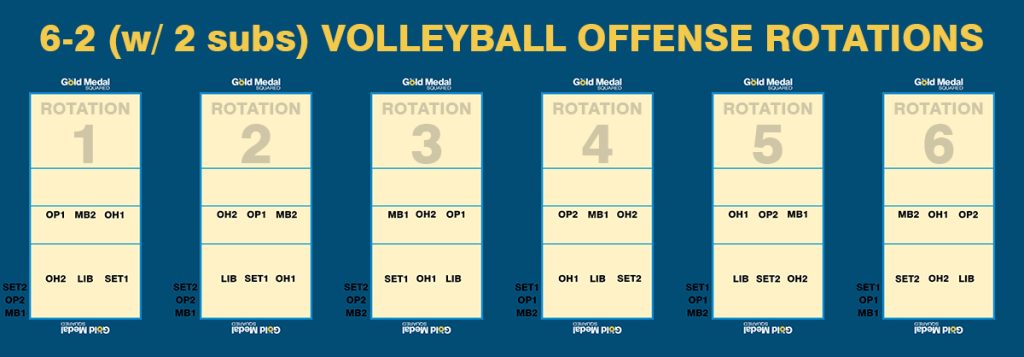
The 6-2 volleyball rotation with subs also gets more athletes on to the court. We all know the value of playing time for athlete development.
The system can also utilize stronger connections between specific hitters and setters.
Advantages summary:
- All players have specialized roles and positions.
- Stronger dedicated right-side attacker and blocker in the front row at all times throughout the entire match.
- Ability to set to three front-row attackers at any time and have a more balanced offensive attack.
- Setters don't have to block and play in the front row.
- Teams are able to give more players playing time during matches.
- Teams can establish connections between specific setters and opposites.
Disadvantages of the “6-2 volleyball rotation with 2 substitutions”
When setters are constantly coming in and out of a lineup, how does this affect the team’s rhythm? Is your team struggling to stay focused and connected with all the changes that are taking place around them?
Similarly, how are the setters and opposites affected by constantly coming into and out of the game? They play for three rotations, sit for three rotations, then return to court.
Another potential problem could be that although opposite players will have the same setter for their 3 front court rotations, the other attackers (middle and left side) will have a mix of both setters. They will need to form connections with two setters, which is not an easy task.
IMPORTANT - MAKE SURE YOU DON’T HAVE A LARGE EFFECTIVENESS GAP BETWEEN BOTH SETTERS. THIS WOULD LIKELY RULE OUT THIS SYSTEM FOR YOUR TEAM.
In rotations 1 and 4, the standard serve-receive formation has the outside hitter hitting on the right, and the opposite hitting on the left (learn more about set names here). This system requires your outside hitter to hit on the right in 33% of your serve-receive formations. For some teams, this would be considered a disadvantage.
On many teams, the setter plays a vital role in leading the team. They are the link between the defense/serve reception unit and the offense. They have to understand the game plan of the coach and be able to execute it.
If setters are switching in and out of the game are they still able to lead the team effectively?
With this system, the opposite player will not be given the opportunity to serve. By not your opposite to serve, you might be missing a chance to put pressure on your opponents.
Note, if you do have a strong serving opposite, you can allow him/her to serve while keeping the setter (the player across from the opposite) in the front row while this opposite serves.
One other important consideration when thinking about adopting this system (particularly with younger players) is the question of ‘Too Early Specialization’.
If players are assigned specialist roles early on in their careers then they risk not fully developing as ‘all-round’ volleyball players.
While specialization may be desirable at the top end of the sport, it is more important for those athletes in the formative years of their volleyball careers to learn how to perform each skill.
Disadvantages summary:
- Middle blockers & outside attackers need to form more than one setter-attacker connection.
- Setting rhythm and momentum can change after substitutions occur.
- If the setter is a leader on the court, is team momentum affected by substituting them off?
- Opposites do not typically serve – are you missing a potential weapon?
- Risk of players not developing an ‘all-round’ understanding of the game.
What type of team might benefit from running the “6-2 System with 2 substitutions?”
For a squad with great depth, this system provides an opportunity for coaches to use the abilities of their athletes. If a squad has 2 strong opposites who really struggle with the defensive aspect of the game, they can focus on their strengths (attack/block) and worry less about the defensive side of their game. If they are capable of attacking a variety of different balls or have different dominant hands, they are also adding in more variables to the team’s offense which gives the opposition more problems to deal with.
This System only works for teams who play in competitions that permit a large number of substitutions (such as high school volleyball, US Junior Club volleyball, and NCAA women's volleyball) where teams have the ability to reverse the substitutions multiple times in a set.
For teams playing under FIVB international rules (such as the NCAA men’s competition), a maximum of six substitutions per set is allowed so it would not be possible to reverse these substitutions more than once in a set.
In the NCAA men’s game (and other competition under FIVB rules), this ‘substitution + reverse substitution’ play can be used for a short term momentum swing but in this case, it isn’t a true ‘6-2 with 2 substitutions’ system.
If a team is trailing in a set, with both scores in the 20’s, and their opposite player is backcourt, then it might make sense to make this move if they have another strong opposite and setter on the bench to increase the front row attacking options. This will likely result in a stronger block, and the setter will be able to spread the offense more effectively (in theory). In a game of narrow margins, this might just swing a game in your team’s favor.
If a team with a front-row setter does not use the slide attack effectively (or at all), or the opposition is not honoring the slide, then it might be effective to have 3 front row attackers instead. Even if the front-row opposite doesn’t get set as much as the outside attackers, having three attackers in the front row increases the number of possible attack options that the opposition block will have to consider.
For many junior clubs, this system is effective as it offers the ability to give more players on the roster game opportunities. However, as mentioned above, it could stifle their overall development. With a lot of money being invested in Club Volleyball, some coaches might feel under pressure to make use of every opportunity to give players as much playing experience as possible. This system is one way of ensuring that at least nine athletes (2 setters, 2 opposites, two outside hitters, two middle blockers, and one libero) get meaningful playing time during a match.
Team style summary:
- Teams with strong squad depth.
- Teams playing in competitions where 12 or more substitutions per set are permitted.
- Teams that need a turnaround in a game but are limited by the number of substitutions allowed.
- Teams that struggle with slide attacks or drawing middle blockers.
6-2 With Subs Summary
Teams start off with a specialist setter in the back row and a specialist opposite attacker in the front row.
- As the setter rotates to the frontcourt, she is replaced by a front-row opposite.
- As the opposite rotates to a backcourt position, she is replaced by a back-row setter.
- The substitutions are reversed every 3 rotations when setters and opposites switch between front row and back row.
FURTHER YOUR KNOWLEDGE:
To see this system in action, sign up for our GMS+ account where we walk you through the rotations and the role changes of each of the positions. From there you can observe how the University of Nebraska Women’s Volleyball Program has used this system in the past. With Coach John Cook’s experience and attention to detail, what you are seeing is a coach looking at the strengths of each of the student-athletes individually and selecting a system that enables them to operate efficiently as a team in offense.
When you watch the video above, take time to notice why this system is effective for the Nebraska program:
- What differences do you notice when looking at the 2 types of opposite attackers in the video?
- How often does the opposition middle blocker close to the pin hitters?
- When is the system forcing the blockers to make decisions?
Check out the video and let us know your thoughts.
For more offensive system blog posts, see below.
5-1 Volleyball Rotations Explained
6-2 Volleyball Rotations Explained (this article)
4-2 Volleyball Rotations Explained
6-6 Volleyball Rotations Explained
6-3 Volleyball Rotations Explained



